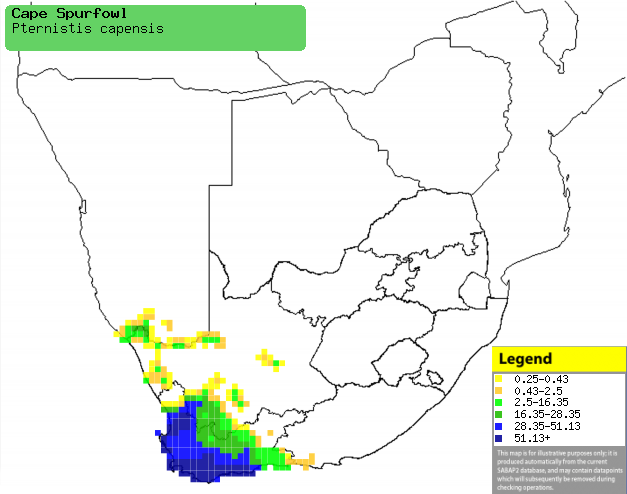|
Pternistis capensis (Cape
spurfowl, Cape francolin)
[= Francolinus capensis]
Kaapse fisant [Afrikaans]; Kaapse frankolijn [Dutch]; Francolin
criard [French]; Kapfrankolin [German]; Francolim do Cabo [Portuguese]
Life
> Eukaryotes >
Opisthokonta
> Metazoa (animals) >
Bilateria >
Deuterostomia > Chordata >
Craniata > Vertebrata (vertebrates) > Gnathostomata (jawed
vertebrates) > Teleostomi (teleost fish) > Osteichthyes (bony fish) > Class:
Sarcopterygii (lobe-finned
fish) > Stegocephalia (terrestrial
vertebrates) > Tetrapoda
(four-legged vertebrates) > Reptiliomorpha > Amniota >
Reptilia (reptiles) >
Romeriida > Diapsida > Archosauromorpha > Archosauria >
Dinosauria
(dinosaurs) > Saurischia > Theropoda (bipedal predatory dinosaurs) >
Coelurosauria > Maniraptora > Aves
(birds) > Order: Galliformes >
Family: Phasianidae
Identification
The only other large, dark francolin within the
distribution of the Cape spurfowl is the
Red-necked spurfowl, which can be easily distinguished by the red skin
around the eyes and on the throat. The contrast between the pale cheeks and the
dark cap of the Cape Francolin distinguishes it from other large dark
francolins. The Grey-winged francolin
and Red-winged francolin are also
found within the distribution of the Cape spurfowl but are much smaller and
lighter coloured with completely different feather patterning.
The male is generally larger than the female, its weight
averaging 980 g versus 770 g in the female. The plumage is similar between the
sexes. The male has 1-2 long leg spurs whereas in the female there is one
reduced spur.
Distribution and habitat
Endemic: distribution is concentrated mainly in the
Western Cape but extends into Northern Cape, southern Namibia and Eastern Cape.
Found mainly in fynbos and karoo but also in gardens and agricultural
settings.
|
 |
|
Distribution of Cape spurfowl in southern Africa,
based on statistical smoothing of the records from first SA Bird Atlas
Project (©
Animal Demography unit, University of
Cape Town; smoothing by Birgit Erni and Francesca Little). Colours range
from dark blue (most common) through to yellow (least common).
See here for the latest distribution
from the SABAP2. |
Call
Predators and parasites
- Predators of chicks
- Blood parasites
- Leucocytozoon macleani
- Leucocytozoon peaolopesi
- Haemoproteus releyi
Food
Mainly eats invertebrates and fallen fruit in summer, while
its winter diet consists mainly of plant matter. The following food items
have been recorded in its diet:
- Plants
- fallen fruit
- bulbs
- corms
- seeds
- berries
- fallen grain
- seeds and funicles of Rooikrans (Acacia cyclops)
- Invertebrates
Courtship
In spring and early summer the males compete for females
and by chasing each other around dominance is determined. The fidelity of the
pair bond might not be all the strong: I observed a male in the Cedarberg chase
after a female with his head low down. He then mounted the female and afterwards
strutted round the female with his feathers puffed out holding his head to one
side and then to the other. After this performance, another male appeared on the
scene and chased him away. One wonders whether he did not sneak in on a current
"relationship" and get some of the action. Genetic studies on other bird species
have shown that this is quite common. Courtship and pair-bonding in the Cape
spurfowl would be worth investigating further.
Breeding
- Nest is a scrape in ground, lined with grass and hidden
among vegetation.
- Breeding season (laying dates):
- Eastern Cape: November (1 record)
- Western Cape: July to January (peak in September)
- Northern Cape: May (1 record)
- After laying 4-8 eggs (1 egg laid every second
day), the female incubates them for 22-25 days until they hatch. Clutches of
more than 8 eggs (14 have been recorded) are thought to be the result of two
females laying in the nest.
- Chicks can fly for short distances after 12 days.
References
-
Hockey PAR, Dean WRJ and Ryan PG (eds) 2005. Roberts
- Birds of southern Africa, VIIth ed. The Trustees of the John Voelcker
Bird Book Fund, Cape Town.
-
Sinclair, I, Hockey, P. and Tarboton, W. 2002. Sasol
Birds of Southern Africa. 3rd edition. Struik, Cape Town.
Text by Hamish Robertson |
